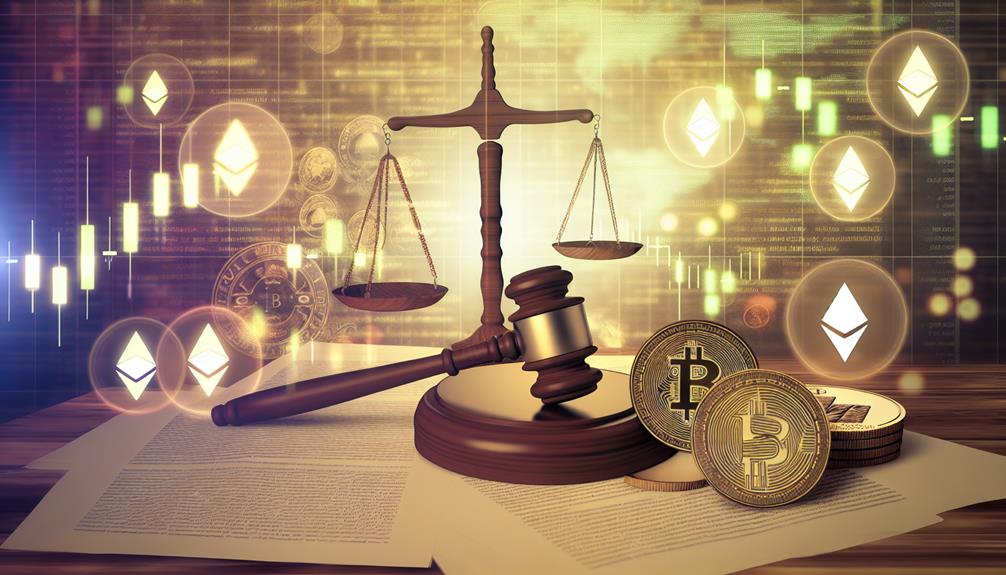When evaluating whether USDC is safe, you might consider its backing, its transparency, and its compliance. While USDC boasts a 1:1 backing with U.S. dollars and undergoes regular audits, it is crucial to recognize that no investment is without risks. You may wonder about the potential vulnerabilities, like market fluctuations and the stability of the institutions holding its reserves. So, as you weigh these factors, you might ask yourself: what does that mean for your confidence in using USDC?
Overview of USDC

USDC, or USD Coin, is a stablecoin designed to maintain a 1:1 peg with the US dollar, providing a digital alternative to traditional fiat currency. This design aims to offer stability in the volatile world of cryptocurrencies. You'll find that USDC is backed by reserves held in U.S. dollars or equivalent assets, which are regularly audited to guarantee trustworthiness and transparency.
When you look at USDC adoption trends, it's clear that this stablecoin has gained traction across various sectors, including decentralized finance (DeFi) and e-commerce. As more platforms integrate USDC for transactions, its utility increases, attracting a diverse user base. The growing acceptance of USDC illustrates a shift towards using cryptocurrencies for practical applications, making it appealing for both retail and institutional investors.
In terms of USDC market performance, you'll notice that it has maintained its peg to the dollar quite effectively, even during periods of market volatility. The stability it offers is a key factor in its rising popularity, especially among investors looking for a reliable digital asset. Additionally, USDC's performance is often analyzed in conjunction with the broader cryptocurrency market, where fluctuations in other cryptocurrencies can influence its adoption and usage patterns.
How USDC Works
To understand how USDC works, it's crucial to examine its backing and reserves, issuance process, and the transparency measures in place. You'll find that USDC is pegged to the US dollar, ensuring stability, while regular audits enhance trust in its reserves. By exploring these elements, you can better assess the operational integrity of USDC.
Backing and Reserves
The foundation of USDC's reliability lies in its backing and reserves, which are vital for maintaining its value. To guarantee that every USDC token is fully supported, the reserve composition is pivotal. This entails holding a mix of assets that can be readily converted into cash, contributing to effective liquidity management.
Here are some key factors regarding USDC's backing and reserves:
- 1:1 Backing: Each USDC is backed by one US dollar held in reserve.
- Regular Audits: Reserves are audited regularly by reputable third parties to guarantee transparency.
- Diversified Assets: The reserves consist of cash and short-term U.S. Treasury bonds to manage risks effectively.
- Liquidity Accessibility: The assets are structured to be liquid, allowing for seamless conversion when needed.
- Regulatory Compliance: USDC adheres to regulatory standards, which enhances trust in its backing.
This robust framework not only supports USDC's value but also fosters confidence among users, knowing that their holdings are securely backed by tangible assets. Understanding this aspect is vital as you consider the safety of your investments in USDC.
Issuance Process
Understanding the issuance process is vital for grasping how USDC operates within the broader cryptocurrency ecosystem. USDC is a stablecoin pegged to the U.S. dollar, and its minting process involves a series of carefully managed steps. When a user wants to acquire USDC, they must deposit an equivalent amount of U.S. dollars into a regulated financial institution. This institution acts as a custodian for the funds.
Once the deposit is confirmed, USDC is minted at a 1:1 ratio, effectively creating new tokens that represent the deposited currency. This minting process is designed to guarantee issuance transparency, allowing users to verify that every USDC in circulation is backed by a corresponding dollar in reserves. Additionally, the process adheres to regulatory standards, which adds another layer of security and trustworthiness.
The issuance of USDC is not only about creating tokens; it's also about maintaining a consistent supply that aligns with demand. This balance is vital for preserving the value of USDC, making it a reliable option for users seeking stability in the volatile cryptocurrency market. Understanding these mechanisms can help you make informed decisions when engaging with USDC.
Transparency and Audits
USDC's commitment to transparency is one of its defining features, setting it apart from many other cryptocurrencies. This transparency is essential for building trust among users and maintaining the stablecoin's integrity in the market. Here's what you should know about USDC's transparency standards and audit frequency:
- Regular Audits: USDC undergoes routine audits by third-party firms to verify that it maintains a 1:1 backing with US dollars.
- Public Reports: The results of these audits are publicly accessible, allowing you to verify the legitimacy of the reserves.
- Compliance: USDC adheres to regulatory standards set by financial authorities, ensuring its operations are above board.
- Real-Time Data: You can access real-time information about USDC's circulating supply and reserve assets, offering insight into its liquidity.
- Trustworthy Partnerships: USDC is issued by regulated financial institutions, reinforcing the reliability of its backing.
These features not only enhance USDC's transparency standards but also contribute to its overall safety in the volatile cryptocurrency landscape. By staying informed about these audits and reports, you can make more confident decisions regarding your investments in USDC.
Regulatory Environment

When it comes to the regulatory environment surrounding USDC, it's vital to recognize that this digital currency operates within a complex landscape shaped by various governmental policies and financial regulations. As a stablecoin, USDC aims to maintain a 1:1 peg to the US dollar, which necessitates strict adherence to regulatory compliance. This compliance is fundamental not only for user trust but also for meeting the expectations set forth by financial authorities.
Government influence plays a significant role in shaping the regulations that govern digital assets like USDC. Regulatory bodies are increasingly focusing on cryptocurrencies, with many jurisdictions developing frameworks that outline how these assets should be treated. For instance, the Financial Crimes Enforcement Network (FinCEN) and the Securities and Exchange Commission (SEC) have provided guidance on anti-money laundering (AML) measures and securities laws that impact how stablecoins can operate.
Your understanding of the regulatory environment is vital for evaluating the safety of USDC. Regulatory compliance isn't just a box to tick; it serves as a foundation for stability and security in the digital currency market. Stablecoins like USDC that actively engage with regulators and adapt to evolving policies stand a better chance of maneuvering potential legal challenges. As regulations continue to evolve, it's wise to stay informed about how these changes might affect USDC and other digital currencies.
Security Measures in Place
The security measures in place for USDC are designed to instill confidence among users and investors. These measures guarantee that your assets are safeguarded against potential threats and that transactions remain secure. Here's a breakdown of some key security features:
- User Authentication: USDC employs robust user authentication protocols to verify identities before allowing access to accounts. This helps prevent unauthorized access.
- Transaction Encryption: Each transaction is encrypted using advanced cryptographic techniques, guaranteeing that your data remains confidential during transfers.
- Regular Audits: USDC undergoes regular third-party audits to verify that reserves are maintained and that the system operates securely and transparently.
- Compliance with Regulations: By adhering to stringent regulatory standards, USDC aligns itself with best practices for financial security, reinforcing trust among its users.
- Multi-Signature Wallets: Funds are stored in multi-signature wallets, requiring multiple approvals for transactions. This adds an additional layer of security against unauthorized withdrawals.
These measures collectively create a robust security framework that helps protect your investments in USDC. While no system is entirely immune to risks, the combination of user authentication, transaction encryption, and regular audits provides a solid foundation for security. As you consider using USDC, it is crucial to understand these protective measures and how they contribute to a safer digital currency experience.
Risks and Vulnerabilities

Despite the security measures in place, risks and vulnerabilities still exist within the USDC ecosystem. While USDC aims to maintain a stable value, market fluctuations can cause its peg to waver, leading to potential losses for users. Liquidity risks also emerge, particularly during times of high demand when users may struggle to convert USDC back into fiat currencies or other cryptocurrencies without facing unfavorable rates.
Smart contract vulnerabilities pose another significant risk. If a flaw is discovered in the code governing USDC, it could lead to unauthorized access or funds being lost. Counterparty risks are present as well, since USDC relies on various institutions to hold the underlying assets. Any instability or failure of these institutions can jeopardize the integrity of the stablecoin.
Regulatory changes can also impact USDC's viability. As governments worldwide refine their approach to cryptocurrencies, new regulations may impose constraints that affect USDC's operations, potentially making it less attractive to users. In addition, technological failures, whether due to hacks or system outages, can disrupt transactions, causing inconvenience and financial loss.
Economic instability can exacerbate these challenges, as a downturn may lead users to withdraw funds en masse, further straining the system. To navigate these risks effectively, user education is essential. Understanding the complexities of USDC and the broader cryptocurrency landscape can empower you to make informed decisions, ultimately reducing your exposure to potential vulnerabilities.
Comparison With Other Stablecoins
Evaluating USDC's safety involves understanding how it stacks up against other stablecoins in the market. You'll find that USDC has gained traction, particularly due to its regulatory compliance and backing by reputable firms. However, it faces stiff competition from other established players like Tether (USDT) and Binance USD (BUSD). Here are some key factors to assess when comparing these stablecoins:
- Regulatory Compliance: USDC is known for its stringent adherence to regulations, which may provide added security for users.
- Transparency: Monthly audits of USDC by third-party firms enhance trust among users, unlike some competitors who lack similar transparency.
- Liquidity: USDC adoption trends show increasing usage in DeFi platforms, ensuring it remains liquid and easily convertible.
- Market Capitalization: While USDC's market cap is substantial, it's worth noting that USDT still holds the largest share, indicating strong market competition.
- Backing Assets: USDC is fully backed by US dollar reserves, while some rivals may have less clarity on their backing assets.
These factors contribute to USDC's positioning within the stablecoin landscape. While it boasts strong regulatory frameworks and transparency, its competition remains fierce. Understanding these dynamics can help you make informed decisions about using USDC compared to other stablecoins available in the market. As you weigh your options, evaluate how these attributes align with your financial goals and risk tolerance.
User Experiences and Feedback

When considering USDC, it's crucial to look at user experiences and feedback regarding its security features. Many users express varying levels of trust, influenced by both positive interactions and common concerns they've encountered. By analyzing these perspectives, you can gain a clearer understanding of USDC's reliability in the broader cryptocurrency landscape.
Security Features Overview
In recent years, user experiences and feedback regarding the security features of USDC have become increasingly pivotal in evaluating its reliability as a stablecoin. Many users appreciate USDC's robust security measures, particularly its use of smart contracts and cryptographic security protocols. These elements are designed to protect user assets and guarantee transaction integrity.
Here are some key security features highlighted by users:
- Smart Contracts: Automate transactions while minimizing human error.
- Cryptographic Security: Protects data integrity and confidentiality during transactions.
- Regular Audits: USDC undergoes frequent audits by reputable firms, enhancing transparency.
- Regulatory Compliance: Adheres to established regulations, promoting trust among users.
- User Feedback Mechanism: Actively encourages user input for continuous improvement.
These features collectively contribute to a safer environment for users, fostering a sense of confidence in utilizing USDC. Users have reported feeling reassured by the combination of advanced technology and consistent oversight. Ultimately, the feedback reflects a growing acknowledgment of USDC's commitment to maintaining a secure platform in the rapidly evolving cryptocurrency landscape.
User Trust Levels
User trust levels in USDC have been shaped considerably by firsthand experiences and ongoing feedback from the cryptocurrency community. Users often express their confidence based on the transparency and operational integrity of USDC, which is backed by reputable reserves. When evaluating trust metrics, you'll notice that many users highlight the consistent audits and the governance structure behind USDC as key factors in building assurance.
Moreover, user experiences vary; while some report high satisfaction and a reliable transactional process, others remain cautious due to the volatility inherent in the broader cryptocurrency market. This duality in feedback impacts overall user confidence, as trust metrics fluctuate based on individual experiences and external market conditions.
Community forums and social media platforms serve as hotbeds for dialogue, where users share insights and concerns, further influencing the perception of USDC's safety. Your trust level may also be swayed by the experiences of others, particularly those with substantial holdings or frequent transactions. Ultimately, a thorough understanding of user experiences can enhance your assessment of USDC, helping you gauge its reliability in the ever-evolving landscape of digital currencies.
Common Concerns Raised
Concerns regarding USDC often stem from individual experiences and broader market dynamics. Users frequently express anxiety regarding the stability and security of their assets, especially during periods of market volatility. This uncertainty can lead to hesitation in adopting USDC as a medium for transactions or savings.
Some common concerns raised include:
- Lack of Transparency: Users feel uncertain about the processes behind USDC's backing and reserve management.
- Regulatory Risks: With changing regulations in the crypto space, users worry about potential implications for USDC's future.
- Market Volatility: Even though USDC is a stablecoin, users are concerned about how fluctuations in the crypto market can affect their holdings.
- User Education: Many individuals lack sufficient knowledge about how stablecoins operate, which can lead to misconceptions.
- Counterparty Risks: There's apprehension about the trustworthiness of the institutions managing USDC reserves.
Addressing these concerns through improved user education and transparent practices can foster greater confidence in USDC as a reliable asset. Understanding these issues can help you navigate the landscape more effectively.
Frequently Asked Questions
Can I Store USDC in a Hardware Wallet?
You can store USDC in a hardware wallet, which offers enhanced security compared to online options. This method guarantees your assets are offline, minimizing risks. Always verify compatibility with your chosen hardware wallet for ideal USDC storage.
How Can I Convert USDC to Cash?
To convert USDC to cash, you've got several options. Think of it like maneuvering through a busy marketplace—explore exchanges, peer-to-peer platforms, or even ATMs offering USDC conversion methods for easy USDC cash options.
Are There Fees for Using Usdc?
Yes, there're fees for using USDC. You'll encounter transaction costs and network fees, which can vary depending on the platform or exchange. It's smart to compare rates to minimize your overall expenses.
What Exchanges Accept USDC for Trading?
Many exchanges accept USDC for trading, tapping into robust USDC liquidity pools. As you explore these platforms, keep an eye on USDC market trends to maximize your trading potential and make informed decisions.
Can USDC Be Used for International Transactions?
You can use USDC for international transactions, facilitating cross-border payments. Its currency stability makes it appealing for users seeking reliable alternatives to traditional methods, enhancing efficiency in global commerce while minimizing volatility risks typically associated with other cryptocurrencies.
Conclusion
In the domain of stablecoins, USDC shines as a beacon of stability, thanks to its rigorous backing and transparency. While it's not without its shadows—like market fluctuations and potential liquidity hiccups—its regulatory compliance helps foster confidence. By understanding both its strengths and vulnerabilities, you can navigate the crypto landscape more wisely. Ultimately, USDC may just be the dependable companion you need in your digital currency journey, but a cautious approach is always wise.
